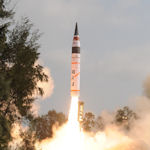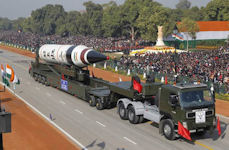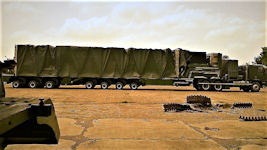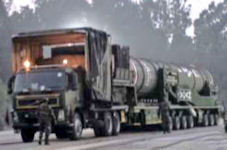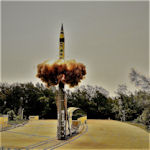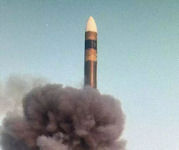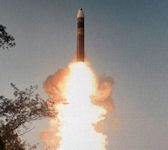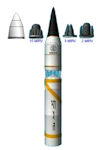Agni-V
 Narendra Modi stated 11 March 2024 "Proud of our DRDO scientists for Mission Divyastra [Agni-D?], the first flight test of indigenously developed Agni-5 missile with Multiple Independently Targetable Re-entry Vehicle (MIRV) technology." The flight test named 'Mission Divyastra' was carried out from Dr APJ Abdul Kalam Island in Odisha. Various Telemetry and radar stations tracked and monitored multiple re-entry vehicles. The mission accomplished the designed parameters. It is suspected that the weapons system was tested within a range of 3,550 km, owing to the announcement of a no-fly NOTAM -- meaning notice to airmen -- in that range.
Narendra Modi stated 11 March 2024 "Proud of our DRDO scientists for Mission Divyastra [Agni-D?], the first flight test of indigenously developed Agni-5 missile with Multiple Independently Targetable Re-entry Vehicle (MIRV) technology." The flight test named 'Mission Divyastra' was carried out from Dr APJ Abdul Kalam Island in Odisha. Various Telemetry and radar stations tracked and monitored multiple re-entry vehicles. The mission accomplished the designed parameters. It is suspected that the weapons system was tested within a range of 3,550 km, owing to the announcement of a no-fly NOTAM -- meaning notice to airmen -- in that range.
"Divyastra" is a term from Hindu mythology and Indian cultural context. In Hindu mythology, the term "Divyastra" refers to celestial or divine weapons possessed by gods, goddesses, and powerful beings. These weapons are often described as having supernatural powers and capabilities, capable of causing immense destruction or achieving specific objectives. Examples of Divyastras include the Sudarshana Chakra wielded by Lord Vishnu, the Pashupatastra wielded by Lord Shiva, and the Brahmastra, a weapon associated with Lord Brahma.
In a contemporary or metaphorical context, the term "Divyastra" may be used to describe any extraordinarily powerful or potent weapon, whether in a literal sense or figuratively, such as advanced technological weapons or tools that are considered highly effective or influential.
The Agni V could be able to carry 4 or 5 MIRV warheads to a 6,000 km range. Developed in early 1960s, all major countries, including China, have MIRVs. But, this is first time India has publicly acknowledged to have successfully developed this technology. It can help evade enemy anti-ballistic missile system capabilities. MIRV is a technology used in ballistic missile systems where a single missile carries multiple warheads, each capable of being independently aimed at different targets. MIRV technology significantly increases the effectiveness and flexibility of a ballistic missile system by allowing a single missile to strike multiple targets, often located far apart, in a single launch. This capability enhances the strategic and tactical options of a country's nuclear deterrent forces.
The nomenclature "Divyastra ... Agni-5" is at best confusing. The few photographs releeased of the 11 March 2024 flight demonstrate clearly that the stack was a 2-stage missile in the configuration previously associated with the Agni-III designation, rather than the full 3-stage configuration at one time designated Agni-V [setting aside the irregular use of Arabic "Agni-5" rather than Roman Agni-V]. In point of fact, photographs of a test of a full 3-stage Agni-V are absent, and the only available photographs seemingly associated with the Agni-V nomenclature are clearly 2-stage missiles with a much smaller third stage kick motor. The differnce between the Agni-III and Agni-V is this kick stage, atop which the single large RV is mounted.
The MIRV technology had been under development since the first test of Agni 5 in 2012. The original plan was to have it for Agni 6 series of missiles, a project which is yet to take-off. The MIRV technology was finalised with the Agni Prime missile and then after the tests, the decision was taken to go for Agni 5 MIRV as well. The single-warhead Agni-III and Agni-V have a large conical re-entry vehicle, while the Divyastra MIRV version has much less pointy Ogive (pronounced "Ojive") payload shroud enclosing multiple warheads. Artist concepts of such a payload shroud were previously associated with the full 3-stage Agni-VI designation.
In the case of the Agni-Divyastra, the semi-spherical solid propellant kick stage is replaced by a post-boost control system (PBCS), part of the "post-boost vehicle" (PBV). This "self-contained dispensing mechanism separates from the final stage of a missile together with the front section and that independently targets and releases the reentry vehicle or reentry vehicles and penetration aids. The PBCS plays a crucial role in guiding and controlling the liquid-fueled post-boost vehicle (PBV) after the booster stage(s) have completed their task of propelling the vehicle into the desired trajectory. The PBCS includes sensors, such as inertial measurement units (IMUs), GPS receivers, and possibly star trackers, to accurately determine the vehicle's position, velocity, and orientation. This information is used to calculate necessary trajectory adjustments. Depending on the mission requirements, the PBCS may control the propulsion system of the post-boost vehicle. This could involve regulating engine thrust, managing propellant flow, and executing maneuvers to fine-tune the trajectory. The PBCS continuously monitors the vehicle's trajectory and compares it to the desired path. If deviations occur due to factors like atmospheric drag, wind, or inaccuracies in the initial trajectory, the control system makes corrections to ensure the vehicle stays on course. The PBCS is responsible for precisely releasing each of the multiple warheads into their designated trajectories at the appropriate times and locations. Overall, the post-boost control system is essential for ensuring the success of missions involving rocket launch vehicles, providing the necessary precision and reliability for accurate deployment of multiple warheads. The design and capabilities of the post-boost vehicle can vary significantly depending on the specific mission requirements and the overall architecture of the launch system. The 'Mission Divyastra' project was led by a woman scientist from the country's missile complex in Hyderabad, Sheena Rani, who had been working on the Agni missile systems since 1999. "I am a proud member of the DRDO fraternity that helps protect India," she asserts. She follows in the illustrious footsteps of India's legendary missile technologist 'Agni Putri' Tessy Thomas, who played a key role in the development of the Agni series of missiles.
Known as a 'powerhouse of energy', the 57-year-old is a scientist at the Advanced Systems Laboratory of the Defence Research Development Organisation (DRDO) in Hyderabad. A trained electronics and communications engineer with expertise in computer science Sheena Rani studied at the College of Engineering in Thiruvananthapuram. She worked for eight years at India's foremost civilian rocketry lab, the Vikram Sarabhai Space Center (VSSC).
The three-stage, solid-fuelled, nuclear capable Agni-V missile, developed by the Defense Research and Development Organization (DRDO), has a maximum engagement range of 5,000 kilometers. Agni-V can carry a single 1-ton to 1.5-ton payload (meaning a nuclear warhead) and is configured for carrying multiple warheads which can be guided to separate targets independently -- thereby giving the missile a MIRV (multiple independently targeted re-entry vehicle) capability. This is a major technological achievement combining as it does guidance and control with miniaturisation of the warhead. Thus, Agni-V will be fitted with a PBCV (post boost control vehicle) and a rigorous post-launch technical evaluation will establish the credibility of the missile and its MIRV index.
Images released 15 June 2021 depict the Strategic Forces Command (SFC) Telar 8x8 (Volvo), an Agni-V canister, and a retractable cover that some interpreted as camouflage, but whch may just be an environmental shelter. DRDO has a historic reputation for “project folding” — the tendency to pitch a missile test as a technology demonstrator and immediately lobby for the next missile that incorporates upgrades.
A successful launch of the Surface to Surface Ballistic Missile, Agni-5, was carried out on October 27, 2021 at approximately 1950 hrs from APJ Abdul Kalam Island, Odisha. The Indian Government stated "The missile, which uses a three-stage solid fuelled engine, is capable of striking targets at ranges up to 5,000 kilometres with a very high degree of accuracy. The successful test of Agni-5 is in line with India’s stated policy to have ‘credible minimum deterrence’ that underpins the commitment to ‘No First Use’."
According to the Indian media, the test launch of the Agni-5 has two aspects: first, it is the first user launch of the country’s first intercontinental ballistic missile since the establishment of the Strategic Command of the Three Armed Forces in India; second, the Agni The -5" missile has been tested seven times before, but this is the first night launch. The Indian media also pointed out in the report that the successful test firing of the "Agni-5" was carried out during the ongoing confrontation between the Chinese and Indian armies in the eastern part of the so-called "Ladakh" area, and claimed that the missile had already sent the missile to the northernmost part of China. The region is included in the scope of the attack, which "sends a strong strategic signal to China."
India developed a 5000 km range variant of the Agni. More importantly it has what is called the MIRV capability which is the ability to carry more than one warhead and being able to engage with multiple targets. Agni V would be a three-stage, all composite, solid propellant fuelled and advanced version in the Agni Class of Intermediate Range Ballistic Missiles. Most of the systems for the Agni V would be from Agni III. "We've started the design work on Agni-V. 5,000 km is what the country needs and that's what we're working on," says Agni Program Director, Avinash Chander, said in May 2008. "The development process has already begun and in the next two years, the design should be ready", said Mr Chander.
In February 2009 it was reported that a senior official of the Defence Research and Development Organisation (DRDO) said that India was likely to fire its Agni-V ballistic missile with a range of 5,000 km by the end of 2010. "We should be able to do something before December 2010," DRDO chief M. Natarajan said. After the successful test of the 3,500 km range Agni-III in May 2008, scientists were working on the first and second stage of the missile to increase its range to 5,000 km. "We will be working on capitalising the first and second stages," Natarajan explained. The government has not considered an 8,000-km range ICBM. Agni-V, for which the government has sanctioned around Rs 2,500 crore, is likely to have solid propellants.
The Agni-5 is a three-stage, solid-fuel missile but its first stage consists of a metallic case rocket motor, while the second and third stages have composite case motors. The work on the nuclear-capable Agni-V basically revolves around incorporating a third composite stage in the two-stage Agni-III, along with some advanced technologies like ring laser gyroscope and accelerator for navigation and guidance. Defence scientists want the Agni-V to be a canister-launch missile system to ensure it has the requisite operational flexibility to be fired from any part of the country.
On 19 April 2012 India said it had successfully test-fired a new missile capable of carrying a nuclear warhead as far as Beijing - announcing itself as a major "missile power." Indian media showed video of the long-range Agni-V missile in-flight after its launch from a test range in the eastern state of Orissa. Prime Minister Manmohan Singh congratulated the country's scientists for contributing to the country's "self reliance in defense."
Ministry of Defence reported 19 April 2012 that India’s maiden Long Range Ballistic Missile (LRBM) AGNI-V (A-5) was successfully flight tested. The flawless auto-launch of the missile started at 08:04 hours. Piercing the thin cloud cover, the missile took off from the launch pad at Wheeler’s Island in Odisha at 08:07 hours and started rising exactly the way it was designed for. The missile, with a range of more than 5000 kms, followed the entire trajectory in copybook style perfection as the three stages of Propulsion dropped and fell at appropriate intervals into the Bay of Bengal.
The three propulsion stages, developed completely indigenously by DRDO, performed exactly the way they were intended to. The indigenously developed Composite Rocket Motors performed well, signifying the country’s stride and complete self-reliance in this complex propulsion technology. Ships located in midrange and at the target point tracked the Vehicle and witnessed the final event. Radars and electro-optical systems along the path monitored in real time all the parameters of the Missile.
A number of new technologies developed indigenously were successfully tested in this A-5 Mission. The redundant Navigation systems, very high accuracy Ring Laser Gyro based Inertial Navigation System (RINS) and the most modern and accurate Micro Navigation System (MINS) ensured the Missile reach the target point within few meters of accuracy. The high speed onboard computer and fault tolerant software along with robust and reliable bus guided the Missile flawlessly.
The Vice-President Shri M. Hamid Ansari, Prime Minister Dr Manmohan Singh, Defence Minister Shri AK Antony and National Security Advisor (NSA) Shri Shiv Shankar Menon hailed the launch of the Agni-V. Dr Singh and Shri Antony spoke to DRDO chief Dr VK Saraswat and Programme Director Shri Avinash Chander and greeted the DRDO Scientists on the A-5 success. Air Marshal K.J. Mathews, Commander-in-Chief, Strategic Forces Command (C-in-C, SFC), who witnessed the launch, said that the success of Agni-V is a historic event for India. Dr V.G. Sekaran, Director, Advanced Systems Laboratory (ASL), Dr S.K. Chaudhari, Director, Research Centre IMARAT (RCI), Shri A.K. Chakrabarti, Director, Defence Research and Development Laboratory (DRDL), Shri S.P. Dash, Director, Interim Test Range (ITR), Shri Guruprasad, Director, Research & Development Engineers (R&DE Engineers, Pune) were present during the launch operations. Shri R.K. Gupta, Project Director guided the team of Scientists and employees of DRDO during the launch activities.
The Defence Minister Shri AK Antony described the maiden test flight of Long Range Ballistic Missile (LRBM) Agni-V as a great moment for India and its scientific community. Shri Antony spoke to DRDO chief Dr VK Saraswat and Project Director Shri Avinash Chander immediately after the event and congratulated the entire team for the immaculate success. Shri Antony said the achievement was a major milestone in the country’s Missile Programme and it reminds him of the untiring efforts of numerous unsung scientists of DRDO who had "worked relentlessly years together to bring the nation to this threshold". Shri Antony also spoke to former DRDO chief Mr M. Natarajan and fondly remembered his contribution to various projects of the organisation.
India's Defense Research and Development Organization chief Vijay Saraswat told Indian media that the country now has missile capabilities that match with the world's elite military powers. "The successful launch of Agni V missile is a tribute to the sophistications and commitment to national causes on the part of India's scientific technological community," said Singh. "I congratulate all the scientists and technologists who have been associated with this important project and I sincerely hope that in years to come our scientists and technologists will contribute a lot more to promoting self reliance in defense and other walks of national life."
When asked about the launch at a press briefing in Beijing, Chinese Foreign Ministry spokesman Liu Weimin said China and India are not competitors, but partners. He said both sides should work together to deepen strategic cooperation, promote mutual development and maintain peace and stability in the region. China's communist party newspaper, the Global Times, responded to India's test launch with a warning of its own, saying "India would stand no chance in an overall arms race with China" for the foreseeable future.
Defence Research and Development Organisation (DRDO) director general and scientific adviser to the defence minister V.K. Saraswat told India Strategic magazine in April 2013 that in terms of missile range, Indian scientists had achieved whatever was assigned by the government (about 5000 km) but the effort was now to develop a MIRV capability.
On 31 January 2015 India successfully test-launched the nuclear-capable, 5,000 kilometer-range Agni-5 missile. "The missile, witnessed a flawless 'auto launch' and detailed results will be known after all data retrieved from different radars and network systems," the Integrated Test Range director MVKV Prasad said, the Hindustan Times reported. The test launch was conducted from a mobile launcher, in the third such test since April 2012.
India successfully carried out a fourth test of its nuclear-capable, intercontinental Agni-V missile on 26 December 2016. It is the fourth developmental and second canisterised trial of the long range missile. While the first test was conducted on April 19, 2012, the second test was carried out on September 15, 2013 and the third on January 31, 2015 from the same base. The 17.5-meter-long, 50-ton surface-to-surface missile was test fired from Abdul Kalam Island, off the coast of the eastern Odisha state, and splashed down near Australian waters.
The missile can hit targets more than 5,000 kilometers away, effectively putting China's northernmost areas within range of Indian nuclear weapons. Unlike other missiles of Agni series, the latest one ‘Agni-5' is the most advanced having some new technologies incorporated with it in terms of navigation and guidance, warhead and engine.
Many new technologies developed indigenously were successfully tested in the first Agni-5 trial. The redundant navigation systems, very high accuracy Ring Laser Gyro based Inertial Navigation System (RINS) and the most modern and accurate Micro Navigation System (MINS) had ensured the Missile reach the target point within few metres of accuracy. The high-speed on board computer and fault tolerant software along with robust and reliable bus guided the missile flawlessly.
Indian leaders welcomed the successful test of the Agni. Prime Minister Shri Narendra Modi has congratulated DRDO and its scientists on the successful test firing of Agni V. “Successful test firing of Agni V makes every Indian very proud. It will add tremendous strength to our strategic defence. The successful test firing of Agni V is the result of the hardwork of DRDO and its scientists. I congratulate them “, the Prime Minister said.
The missile was launched from a mobile platform, which gives the armed forces flexibility to transport and fire it swiftly from anywhere they want. India's nuclear doctrine emphasizes a “no-first-use” policy and New Delhi’s official position is that its nuclear deterrence is not country-specific.
The test ensured the Agni-V missile is operational. After this test, the missile will be handed over to India’s strategic forces command for operationalization. They would undertake two tests and subsequently the missile will come into India’s armory. Agni-V would now undergo at least two user-trials by the tri-service Strategic Forces Command (SFC) before full-scale production and induction. It would take another couple of years for Agni-V to be inducted into SFC, which manages the country's nuclear arsenal, in adequate numbers.
|
NEWSLETTER
|
| Join the GlobalSecurity.org mailing list |
|
|
|




